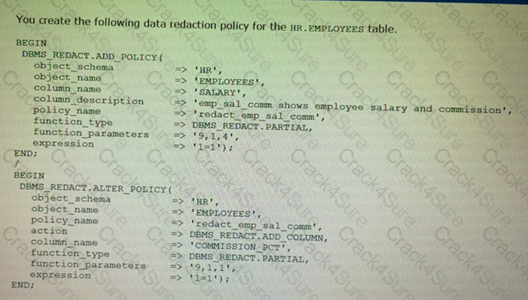We at Crack4sure are committed to giving students who are preparing for the Oracle 1z0-497 Exam the most current and reliable questions . To help people study, we've made some of our Oracle Database 12c Essentials exam materials available for free to everyone. You can take the Free 1z0-497 Practice Test as many times as you want. The answers to the practice questions are given, and each answer is explained.
Real-Time ADDM detects a high-load performance issue within the database. Which condition triggered it?
Which two statements about multitenant architecture are true?
Which two are client-side components of Oracle Data Guard Broker?
Which statement about Online Move Data file is true?
Which process is responsible for writing the contents of database buffers to data files?
In which situation would you use static database registration for a listener?
Why does performance degrade when many UPDATE, INSERT, or DELETEstatements are issued on a table that has an associated bitmap index?
Which is the default isolation level in Oracle Database 12c?
Identify three key properties of a transaction in Oracle Database 12c.
Which two statements are true about transactions in Oracle Database 12c?
Identify the correct order of consolidation density.
What happens if you execute these SQL statements?
SQL> show con_name
CON_NAME
--------------------------------
CDB$ROOT
SQL> create user 1_freed identified by y container=current;
Which three statements about replication options are true?
A standby database is in mounted state and you are required to perform a failover to the physical standby. Which solution is best suited forthis scenario?
Consider 10 scenarios that result in database downtime. Which five of them are considered as planned downtime?
What new role in Oracle Database 12c encompasses the administrative privileges required for backup and recovery?
You are about to apply a patch to a database. Which recommended action is incorrect?
Which three background processes are mandatory in a database Instance started with a minimally configured Initialization parameter file?
Which three statements represent the benefits of multitenant architecture for database consolidation?
Your customer has three data centers in three different locations, location A has their production database running on Oracle Database 12c. They want to replicate the data from location A to location B. which is 50 miles away and is used for disaster protection and database rolling upgrades. They also want to create a replica database at location C, which must be open in read-write mode, while synchronizing with the primary database.
Which two solutions would you recommend to your customer?
For which database operation do you need the database to be in MOUNT state?
Which command do you use to check for block corruption by validating the database?
Examine the statements:
SQL> CREATE TABLESPACE MYTBS DATAFILE '/disk1/mytbs_l.dbf ' SIZE 10M;
SQL> CREATE TABLE mytab (id NUMBER, descr VARCHAR2 (100) )
PARTITION BY RANGE(id) (
partition pi values loss than (100000) tablespacemytbs storage (initial lm),
partition p2 values less than (MAXVALUE) tablespacemytbs storage (initial 1m)
);
When inserting data, you get the error:
ORA-01688: unable to extend table SYS.MYTAB partition P2 by 128 in tablespace MYTBS
Which three operations would allow you to insert data without getting the error message?
Consider an application in which memory required for each session is 400 KB and memory required for each server process is 4 MB. The pool size is 100 and the number of shared servers used is 100. If there are 5000 client connections, what is the amount of memory used by a dedicated server?
Which two statements are true regarding SQL*Plus?
Which statement about the Queryable Patch inventory feature is false?
Examine the error:
GSM-45054: GSM error or NET-40006: unable to start GSH
What is the cause of this error, and what troubleshooting steps should you perform?
Which two options can you use to list Oracle Database 12c patches by using Queryable Patch Inventory?
Which statement about Storage Snapshot Optimization is correct?
What happens when you execute these SQL statements?
ALTER SYSTEM SET SGA_TARGET = 992M;
ALTER SYSTEM SET SHARED_POOL_SIZE = 0;
ALTER SYSTEM SET LARGE_POOL_SIZE = 0;
ALTER SYSTEM SET JAVA_POOL_SIZE = 0;
ALTER SYSTEM SET DB_CACHE_SIZE = 0;
ALTER SYSTEM SET STREAMS POOL SIZE = 0;
Which statement is true about Enhanced Real-Time ADDM in Oracle Database 12c?
You add the following code in the tnsnames.ora file on a client PC:
sales=
(DESCRIPTION=
(ADDRESS= (PROTOCOL=TCP)(HOST=salesdata) (PORT=1521) )
(CONNECT_DATA=
(SERVICE_NAME=sales.acme)))
Which statement is true about the code with respect to creating a new connect identifier?
In Oracle Database 12c, when does a transaction begin?
An Oracle instance is a combination of______.
You are in the middle of transaction, updating a table. The machine on which the database is running reboots because of a power outage. This causes a database instance failure.
Which statement is true in this situation?
You want to start a global service on your database. Which three conditions must be met?
You want to drop a pluggable database from a multitenant container database that is used for development, which two statements are true?

Which two statements about this policy are true?
Your customer has two CDBs: one for Production and one for development. You are asked to create a new development PDB (salesdev) from an existing production PDB (salesprd). Which two options would accomplish this?
Which database feature can be used for organizing data when there is a very large amount of data?
3 Months Free Update
3 Months Free Update
3 Months Free Update